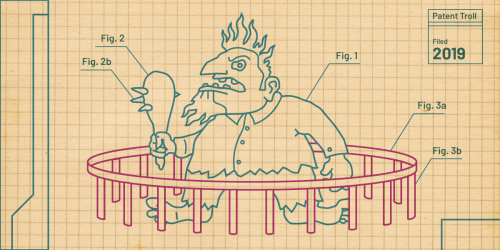Stupid Patent of the Month
Contact tracing is critical for limiting the spread of a contagion like COVID-19, but that doesn’t mean it’s inventive to compare people’s locations using their smartphones. Rather, it’s all the more important to protect the basic methods of public health from bogus patent claims.
The CDC recommends contact tracing for close contacts of any “confirmed or probable” COVID-19 patients. But doing the job has been left to state and local public health officials.
In addition to traditional contact tracing by public health workers, some are using “proximity apps” to track when people are near one another. These apps should be used only with careful respect for user privacy. And they can’t be a substitute for contact tracing done by public health workers. But, if used carefully, such apps could be a useful complement to traditional contact tracing.
Unless someone with an absurdly broad patent stops them.
In April, while many states were still under the first set of shelter-in-place orders, a Utah company called Blyncsy was building a website to let government agencies know that it wanted to get paid—not for giving them any product, but simply for owning a patent they’d managed to get issued in 2019. In news reports and its own press release, Blyncsy said that anyone doing cellphone-based contact tracing would need to license its patent, U.S. Patent No. 10,198,779, “Tracking proximity relationships and uses thereof.”
By September, Blyncsy had begun demanding $1 per resident payments from states that released contact tracing apps, including Pennsylvania, North Dakota, South Dakota, and Virginia.
“State governments have taken it upon themselves to roll out a solution in their name in which they’re using our property without compensation,” Blyncsy CEO Mark Pittman told Wired.
The developer behind North Dakota and Wyoming’s contact tracing apps told Wired that Blyncsy’s threatened patent battle could “put a freeze on new states rolling out apps.”
Given Blyncsy’s $1 per person price point, a state like Virginia, with more than 8 million residents, would be vastly overpaying for contact tracing technology. That state’s app cost $229,000 to develop.
Contact Tracing is Very Good And Very Old
Unfortunately, our patent system encourages the acquisition and use of bad patents like the one owned by Blyncsy. The company’s patent essentially claims technology that’s well over a century old, and could be performed with pencil and paper. Simply adding a smartphone into the works—a “mobile computing device,” as Blyncsy’s patent describes it—doesn’t make the patent valid.
And the patent’s primary claim doesn’t have any technology in it at all. It’s a pure “business method” patent, except that the only business it appears to support is demanding money from state public health departments. Simplifying the language of Claim 1, it describes:
- Receiving data about the location of a first person, who “has a contagion”
- Receiving data about the location of a second person
- Determining if they’re close together
- Determining when they were close together
- Determining whether the “proximity relationship” is positive or negative
- Labeling the second person as being either contaminated or not
That’s just contact tracing, a process that has been done with simple writing and human interviews since at least the mid-19th century. In a famous breakthrough for the field of epidemiology, British doctor John Snow traced an 1854 cholera epidemic near London to a specific water pump on Broad Street.
Patent documents have even more specific descriptions of Blyncsy’s claimed method. Last week, Unified Patents published some prior art for the Blyncsy patent, including a 2003 patent application directed to an “electronic proximity apparatus” that alerts individuals when they are exposed to a contagious disease.
Doing research, writing down the results, and trying to figure out how people got sick isn’t a patentable invention—it’s just basic science. The patent’s other claims are no more impressive. The issuance of the Blyncsy patent isn’t a success story, it’s evidence of glaring flaws in our patent system.
Too often, patents are issued that don’t embody any innovation. These simply become a 20-year-long invitation for a company to demand payment for the innovation and work of others. Sometimes that’s other companies, and sometimes it’s our own governments. In this case, Blyncsy is trying to make a buck by levying what amounts to a tax—but one that only benefits a single, for-profit company.
Unfortunately, we’ve seen patent holders repeatedly try to take advantage of the pandemic. Last year, patent troll Labrador Diagnostics tried to use old patents belonging to the notorious firm Theranos to sue a real firm making COVID-19 tests. Another patent troll sued a ventilator manufacturer. A health crisis is a time to carefully limit, not expand, the power of patents.









